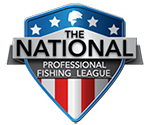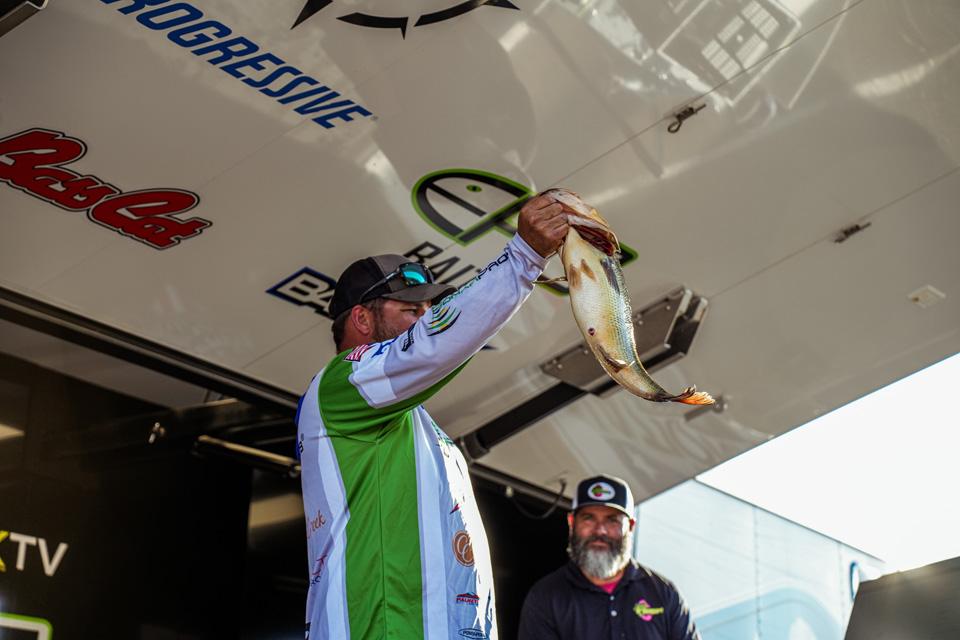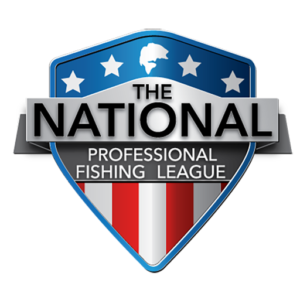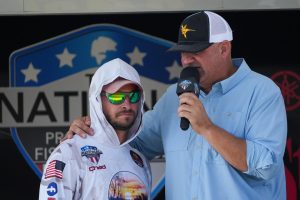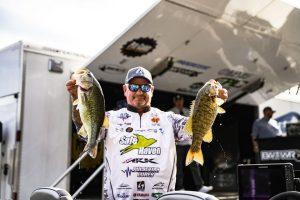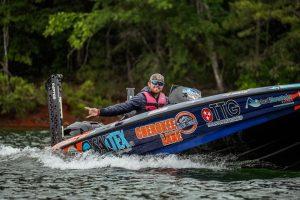Story by Ken Duke | Photos by Tanner & Travis Lyons
Lunker: 6-15 largemouth bass on Day 3
Angler: Trent Palmer (Cumming, Georgia)
Lure: Berkley Choppo 120 (Maverick) — Palmer replaces the stock trebles with #1 or #2 Ichikawa trebles and uses heat shrink tubing to cover the back split ring and tighten its grip on the eye of the hook. The helps to keep the hook somewhat stationary and in a better position to stick a striking bass. When the tubing loosens, he reheats it.
Rod: ALX Rods casting rod — 7-foot-3, medium-heavy
Reel: casting reel (8:1 gear ratio)
Line: 50-pound braid
Method: Lake of the Ozarks is known for its innumerable boat docks. In every tournament on the giant reservoir, boat docks are a “player,” and the NPFL event in October 2024 was no exception. By mid-fall, big bass are often feeding on threadfin and gizzard shad around docks, and the bass are often cruising the shallows together in small groups. Noisy topwaters are often what it takes to trigger their feeding and competitive instincts.
“I use my Garmin 8616 forward-facing sonar unit — rigged by my company, Sonar Pros, using our dedicated harness — to look at the fish that are coming for the bait. It’s valuable to see what’s there, how many, and how big they are. If there’s a wolfpack of bass, it’s a lot easier to trigger them.”
Cast: “The spot that produced my 6-15 was the back corner of a poorly maintained dock,” Palmer says. “The bank had a good mix of rock and erosion control material. I cast over a drooping cable that paralleled the back part of the dock.”
When these fish are feeding in small groups, Palmer believes a steady retrieve works best. “They want to chase at this time,” he says. “If you stop the bait, they often lose interest.” He believes the best retrieve speed offers a a deep, resonant tone that’s about the loudest you can get from the bait.
Lesson: “At this time of year, with the water cooling off, the bigger bass feed in wolfpacks of two to five fish,” says Palmer. “This is a pattern I’ve worked on a lot of lakes that have gizzard shad or blueback herring. It’s great on lakes like Clarks Hill [Georgia-South Carolina], Hartwell [Georgia-South Carolina], Lanier [Georgia], and Murray [South Carolina].”
“I like the hook-up ratio of the plopper-style bait better than a conventional buzzbait, though the buzzbait is great when you need to skip a lure under the dock or under the cables that hold a floating dock in place.”
“The main reason I choose a plopper over a buzzbait in this situation is because it starts instantly. Because it floats, the tail starts turning as soon as you turn the handle of your reel. With a buzzbait, you have to crank a few times before the lure pops to the surface, and that can mean your bait has already passed the key area.”
Exceptional casting accuracy and an acrobat’s touch with a rod and reel definitely help with this pattern. Putting your bait on target often means casting over, under or around pilings, cables, rocks, stumps or other hazards bent on ruining your cast, your bait or long minutes of your fishing day.
